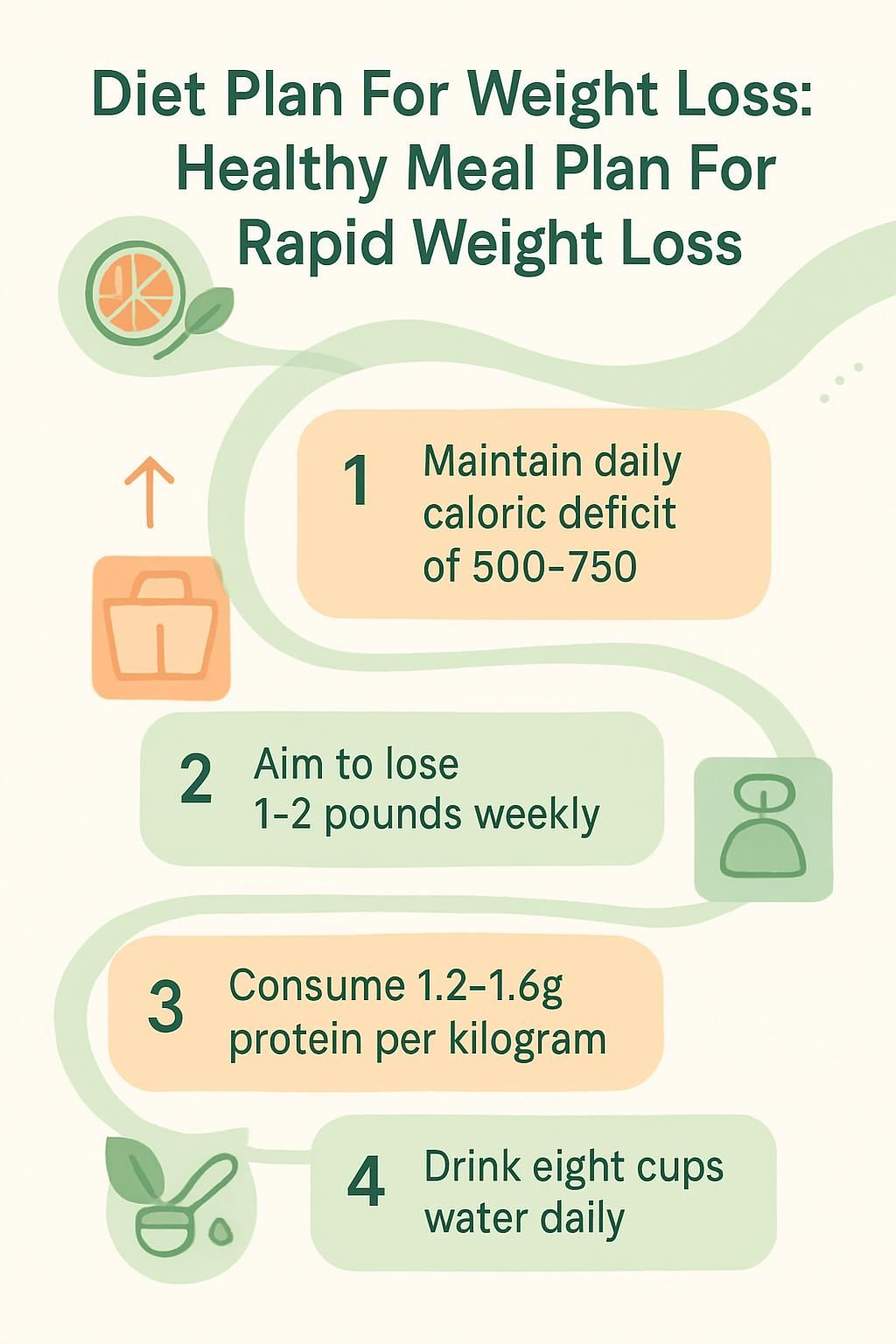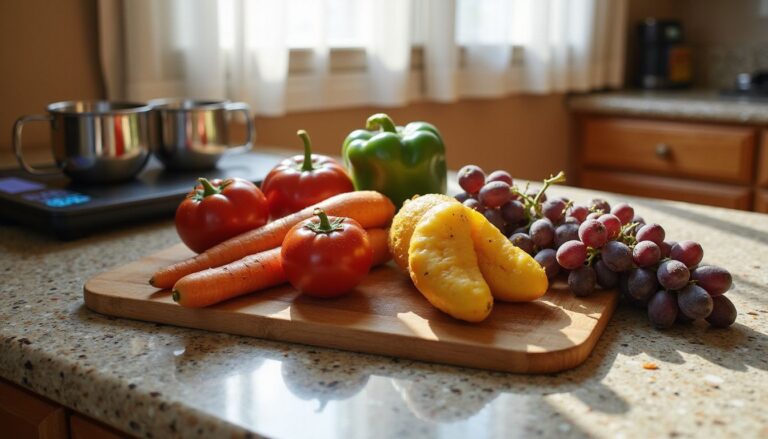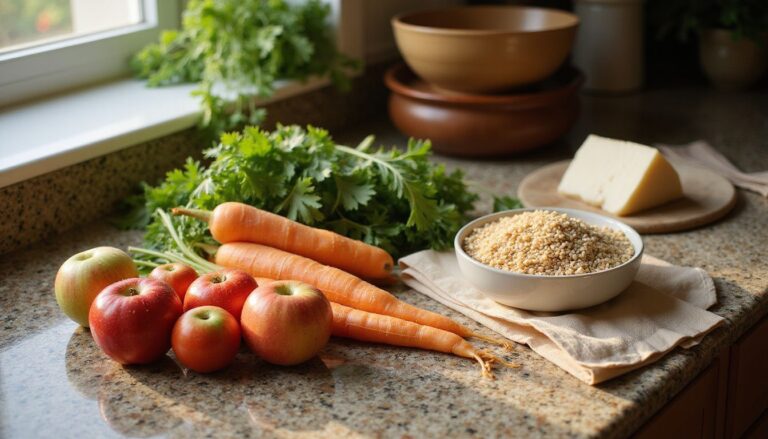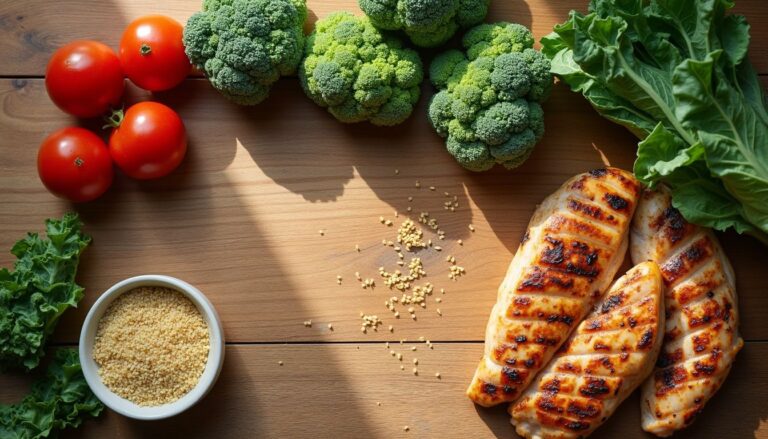Diet Plan For Weight Loss: Healthy Meal Plan For Rapid Weight Loss
Our Nutrition Assistant AI Suite will transform your body. You will lose fat, get toned, and build muscle. Gain confidence and optimal health.
If you try to lose weight and feel unsure where to begin, you are not alone. Many people share this challenge, and a simple diet plan can make the path clearer. I created this guide to help you build an eating plan for rapid weight loss using proven steps and realistic meals.
Experts at Mayo Clinic report that a structured meal plan supports long-term weight management. I focus on practical habits, portion control, and foods that keep you full. Small daily choices add up. Keep reading for tools you can use today.
Key Takeaways
- Safe rapid weight loss usually means a daily deficit of 500 to 750 calories, which supports a loss of 1 to 2 pounds per week, according to the CDC.
- Balanced meals work well: about 30 percent protein, 40 percent carbohydrates from whole grains, and 30 percent healthy fats.
- Lean protein, such as chicken breast, eggs, and salmon, helps preserve muscle and reduces hunger; many experts suggest 1.2 to 1.6 grams of protein per kilogram of body weight per day.
- Replacing processed foods and sugary drinks with vegetables, fruit, whole grains, and nuts lowers risk for diabetes and heart disease in large studies.
- Drinking about eight cups of water daily supports appetite control and weight-loss efforts; regular physical activity strengthens long-term results.

Understanding the Basics of Weight Loss

Weight loss starts with how your body uses energy from food. I focus on healthy eating habits that help maintain a healthy weight and support steady progress.
What is a Caloric Deficit and Why Does It Matter?
A caloric deficit means I eat fewer calories than my body burns through daily activity and exercise. This gap is what drives fat loss. Low-calorie diets often range from 1,200 to 1,500 calories per day. Very-low-calorie diets are closer to 800 calories per day, and they require medical supervision.
When energy in is less than energy out, my body taps stored fat for fuel. That is why every effective diet plan includes portion control and smart food choices. Even modest calorie reductions can lower risk for high blood pressure, type 2 diabetes, and cardiovascular disease over time.
Knowing how protein, carbohydrates, and fats fit your plan makes the process easier. It helps you lose fat while protecting your health and energy levels.
How Do Protein, Carbs, and Fats Affect Weight Loss?
Protein helps preserve muscle during calorie restriction and boosts fullness. I notice fewer cravings when I include lean protein like skinless chicken, seafood, or nonfat yogurt. The Mediterranean diet can help people get this balance through simple, whole foods.
Carbohydrates fuel the body, but the type matters. Whole grains and other high-fiber foods steady blood sugar and improve satiety. A recent study found that fiber from vegetables and whole grains can increase fullness by about 30 percent compared with low-fiber foods.
Healthy fats from olive oil, nuts, and seeds add flavor and support heart health by improving cholesterol levels. Using healthy fats in small amounts helps me feel satisfied without extra dessert calories.
Benefits of a Healthy Meal Plan for Weight Loss
A structured meal plan helps you lose weight and can lower risk for heart disease. Research shows nutritious eating patterns also support control of hypertension, diabetes, and high cholesterol.
How Does a Healthy Meal Plan Promote Sustainable Weight Loss?
Plans like the Mayo Clinic Diet use balanced macronutrients, portion control, and nutrient-dense foods. These steps create a steady caloric deficit, which makes losing 1 to 2 pounds per week realistic and easier to maintain.
Digital tools make it simple to track meals, activity, and goals. I include low-fat options such as salads with hummus or cottage cheese. Whole grains like quinoa and beans add fiber for better digestion and stable blood sugar.
Building these habits in the LOSE IT! phase, then keeping them in the LIVE IT! phase, reduces the risk of conditions such as hypertension and type 2 diabetes while still allowing delicious, healthy choices.
Can a Healthy Diet Help Preserve Muscle During Weight Loss?
Quality nutrition protects muscle while you lose fat. Many experts suggest 1.2 to 1.6 grams of protein per kilogram of body weight each day. I reach this target with foods like eggs, veggie burgers, nuts, and Greek yogurt.
Protein works best with light strength training to maintain muscle. Studies show higher protein diets reduce lean tissue loss compared to low-protein plans.
Maintaining muscle is critical for health and helps keep metabolism steady during rapid weight loss,says Dr. John Smith from Harvard Health.
Protecting muscle lowers the chance of regain and supports long-term physical fitness.
What Are the Overall Health Benefits of a Weight Loss Meal Plan?
A weight loss meal plan helps reduce the chance of diabetes, heart disease, and high blood pressure. Balanced meals with fruit, seeds, and raw veggies make it easier to control calories and improve nutrition.
The American Heart Association notes that a 5 to 10 percent drop in body weight can reduce the risk of heart attack or stroke. Choosing lean proteins, whole grains like oats or rice, and fewer saturated fats supports both fat loss and heart health.
I also sleep better with a plant-forward pattern that includes vegetables, nuts, and healthy fats instead of trans fats. Losing excess weight may ease sleep apnea and supports digestion. Even a simple vegetable soup with cucumbers or sweet potato can support fullness with fewer calories.
Following a realistic plan helps me manage energy at breakfast, lunch, and dinner, and a light dessert like frozen yogurt still fits.
Key Components of a Weight Loss Diet Plan
A strong plan blends nutrition basics with easy daily habits. I focus on balance, portions, and hydration to keep meals satisfying.
Balanced Macronutrient Ratios
Macronutrients are protein, carbohydrates, and fat. A common split for weight loss is 30 percent protein, 40 percent carbohydrates from whole grains like brown rice or couscous, and 30 percent healthy fats such as olive oil or nuts.
Higher protein supports muscle and reduces hunger during low-calorie phases. My go-to diet foods include chicken breast, salmon, eggs, leafy vegetables, and citrus fruit. I rotate meals so the plan stays interesting, for example grilled salmon with roasted vegetables one day, baked chicken with whole-grain pasta the next.
Balanced ratios also limit saturated fat and add fiber from produce. This lowers risk for heart attack or stroke. Portion control works with balanced macros to drive rapid progress.
Portion Control
After I set macronutrient targets, I use portion control to maintain a calorie deficit. Serving sizes are specific, such as 4 ounces of grilled chicken or half a cup of brown rice per meal.
I cap dessert at about 75 calories per day. Measuring foods helps me avoid hidden calories, so I often weigh nuts or milk. Smaller plates make portions feel generous. Even richer items like mayonnaise-based sauces can fit in small amounts.
Hydration and Water Intake
Drinking enough water supports appetite control and metabolism. I often include 1 cup of fat-free milk or unsweetened almond milk with meals for hydration and nutrients.
Studies show drinking water before meals can lower calorie intake, which helps maintain a deficit. Hydration also supports kidney function and digestion. Choosing water, low-calorie drinks, and hydrating foods like fruit and vegetables makes it easier to meet fluid needs.
Most adults do well with about eight cups, or 64 ounces, per day. Needs vary with activity level and health status.
Sample 7-Day Meal Plan for Rapid Weight Loss
Here is a 7-day sample to show how simple cooking methods and thoughtful portions can shape healthy new habits. Use it as a starting point for your own meal plan.
Day 1: Breakfast, Lunch, Dinner Ideas
A successful diet plan starts with clear, practical choices. I keep meals balanced and rely on baking or roasting.
- Breakfast includes ¾ cup bran flakes, 1 banana, and 1 cup fat-free milk for a filling start.
- Lunch contains 2 ounces sliced turkey breast on 2 slices whole-grain bread with lettuce, tomato, and 1 teaspoon mayonnaise; add 1 cup baby carrots, a medium orange, and 1 cup fat-free milk.
- Dinner is 4 ounces grilled salmon with half a cup brown rice; add 1 cup broccoli drizzled with 2 teaspoons olive oil, then finish with 1 cup fresh cantaloupe.
- Whole grains like brown rice provide steady energy due to a lower glycemic impact.
- Lean proteins such as grilled salmon help protect muscle during a deficit.
- Roasting broccoli adds flavor without many calories, which keeps this way of eating enjoyable.
- Milk at breakfast and lunch can help manage appetite while supporting protein needs.
Day 2: Breakfast, Lunch, Dinner Ideas
Day 2 keeps the focus on balanced nutrition and calorie control. I choose foods that protect long-term health.
- Breakfast includes 1 cup cooked oatmeal, ½ cup blueberries, and 1 tablespoon chopped walnuts with 1 cup fat-free milk for fiber and protein.
- Lunch features 1 cup black bean soup, a small whole-grain roll, and 1 cup mixed greens with 2 tablespoons vinaigrette for healthy fats and micronutrients.
- Add 1 cup strawberries for antioxidants and vitamin C with minimal added sugar.
- Dinner is 3 ounces grilled chicken breast with 1 cup roasted sweet potatoes and 1 cup steamed green beans for lean protein and complex carbs.
- Hydration matters; aim for at least eight cups of water to support metabolism and hunger control.
- This structure can support a heart-healthy pattern while promoting steady weight loss.
- Increase physical activity to deepen the caloric deficit without sacrificing muscle mass.
Day 3: Breakfast, Lunch, Dinner Ideas
Day 3 highlights simple, whole foods and measured portions to support weight loss.
- Breakfast: 2 scrambled eggs with 1 slice whole-grain toast and 1 teaspoon butter; add 1 cup mixed berries for vitamins and fiber.
- Lunch: 1 small whole-wheat pita with 2 tablespoons hummus, 1 cup mixed greens, and 1 cup cherry tomatoes; add a medium apple for natural sweetness and fiber.
- Dinner: 4 ounces baked white fish with 1 cup quinoa and steamed asparagus for minerals and fiber.
- Hydration: Drink at least eight cups of water to help control hunger and support metabolism.
- Protein swap: Vegetarians can use grilled tofu or chickpeas instead of fish to maintain protein intake.
- Whole grains: Quinoa and whole-wheat pita digest slowly and aid blood sugar control.
- Colorful produce: Greens, berries, apples, tomatoes, and asparagus provide antioxidants that support health.
Day 4: Breakfast, Lunch, Dinner Ideas
Day 4 continues the plan with filling meals that protect energy and progress.
- Breakfast: Overnight oats with rolled oats, fresh berries, and a diced pear for fiber and vitamins.
- Lunch: White bean soup with a light pesto drizzle; beans supply plant protein and fiber.
- Dinner: Sheet-pan roasted chicken breast with broccolini, onion, and tomatoes for lean protein and antioxidants.
- Hydration: At least eight cups of water can help regulate hunger cues.
- Protein target: I aim for at least 20 grams of protein per meal to protect muscle during calorie reduction.
- Portion accuracy: I weigh cooked chicken or beans with a kitchen scale to sustain the deficit.
- Snack choice: If needed, I pick raw veggies or a small piece of fruit instead of processed snacks.
Day 5: Breakfast, Lunch, Dinner Ideas
Day 5 focuses on nutrient density. Each meal supports a calorie deficit without leaving me hungry.
- Breakfast: 1 cup low-fat Greek yogurt with ½ cup sliced strawberries and 1 tablespoon chia seeds for protein and fiber.
- Lunch: 1 cup lentil soup, a small whole-grain roll, and mixed greens with 2 tablespoons vinaigrette.
- Dinner: 3 ounces grilled shrimp over 1 cup brown rice with 1 cup sautéed spinach; this blends lean protein and complex carbs.
- I drink at least eight glasses of water to support metabolism and avoid thirst-driven snacking.
- Every portion is measured to balance satisfaction and calorie goals.
- I skip added sugars and avoid processed snacks or fast food to support fat loss.
- The plan uses whole grains, lean proteins, healthy fats from chia seeds, and plenty of vegetables.
Day 6: Breakfast, Lunch, Dinner Ideas
Day 6 keeps meals simple, balanced, and easy to prep in advance.
- Breakfast: 2 scrambled eggs with 1 slice whole-grain toast and 1 teaspoon butter, about 14 grams of protein.
- Lunch: Small whole-wheat pita with 2 tablespoons hummus, 1 cup mixed greens, and 1 cup cherry tomatoes for fiber and volume.
- Dinner: 4 ounces grilled chicken with 1 cup roasted vegetables and 1 cup quinoa, about 35 grams of protein total in the meal.
- I drink at least eight cups of water to aid digestion and appetite control.
- Snacks under 100 calories, such as apple slices or carrot sticks, help curb hunger.
- Prepping ingredients the night before prevents skipped meals and rushed choices.
- Each portion stays within my daily calorie budget to support faster progress.
Day 7: Breakfast, Lunch, Dinner Ideas
Day 7 keeps momentum strong with simple, nutrient-dense meals that fit a calorie deficit.
- Breakfast: 1 cup cooked oatmeal, ½ cup blueberries, and 1 tablespoon chopped walnuts for fiber and healthy fats.
- Lunch: 1 cup black bean soup, a small whole-grain roll, and 1 cup mixed greens for steady energy.
- Dinner: 3 ounces grilled salmon with 1 cup steamed broccoli and ½ cup brown rice for lean protein and complex carbs.
- Drink at least eight glasses of water throughout the day.
- Keep snacks to raw vegetables or a small fruit if hunger appears between meals.
- Avoid sugary drinks and processed foods to prevent extra calories.
- Track food intake with an app or journal to improve accountability.
Physical activity amplifies the results of any meal plan. The next section shows how pairing exercise with nutrition speeds progress.
Tips for Customizing Your Diet Plan
I edit my weight loss meal plan to match my lifestyle and tastes. Customizing your plan makes it easier to follow and maintain.
How Do I Adjust My Diet for My Caloric Needs?
I estimate daily calorie needs using age, gender, weight, height, and activity level. Many adult women need 1,600 to 2,400 calories per day, and many adult men need 2,000 to 3,000. For safe, rapid weight loss, I aim for 500 to 750 calories below maintenance, which often means 1 to 2 pounds lost per week, as the CDC notes.
Going below 1,200 calories per day can pose risks unless a healthcare professional supervises the plan. If you are inactive or have a medical condition, talk with your clinician before making big changes.
I also review portion sizes and keep a balance of protein, carbohydrates, and healthy fats. Lean meats, fish, or legumes help me meet protein needs while staying within my budget of calories.
How Can I Include My Favorite Foods in a Weight Loss Plan?
I keep favorite foods by using portion control. The Mayo Clinic Diet lets me enjoy all food groups. If I crave pizza, I have one slice with a large salad instead of several slices.
Flexible plans help people stick with their goals and may prevent binge eating. I also choose lower-calorie prep methods. For example, I bake chicken wings instead of frying or switch to whole-grain pasta for extra fiber.
These swaps protect progress while keeping meals enjoyable.
What Are Common Dietary Restrictions to Consider?
Many plans must consider allergies, diabetes, heart disease, or personal preferences. I always check labels for common allergens like gluten, nuts, dairy, and eggs.
Some people need low-sodium meals or reduced sugar for diabetes management. The American Heart Association suggests limiting sodium to less than 2,300 milligrams per day. Vegetarian, vegan, or gluten-free approaches can also fit a healthy weight loss plan by choosing the right proteins and grains.
With a few adjustments, most restrictions can be included without slowing progress.
Foods to Include in a Healthy Weight Loss Diet
Choosing the right foods gives you more nutrients per calorie and helps you feel full longer. Here are staples I use in a healthy diet plan.
Which Lean Proteins Are Best for Weight Loss?
Chicken breast, salmon, shrimp, white fish, turkey breast, and eggs offer high-quality protein with fewer calories than many red meats. A 3-ounce grilled chicken breast provides about 26 grams of protein with under 140 calories. Salmon adds omega-3 fats that support heart health and fullness.
Swapping processed meats for these options boosted my energy and reduced cravings. Shrimp and white fish are low in fat but still deliver about 20 grams of protein per serving. Turkey breast helps preserve muscle during a deficit. Eggs are versatile and keep me satisfied.
What Are the Benefits of Whole Grains?
Whole grains like brown rice, quinoa, whole-wheat pita, and whole-grain bread supply fiber, B vitamins, and minerals. People who eat more whole grains have a lower risk of heart disease and type 2 diabetes in large cohort studies.
The Dietary Guidelines for Americans recommend making at least half your grains whole. Fiber digests slowly, so I stay full longer when I choose oatmeal or whole-wheat toast. Replacing refined grains with whole grains also helps control cravings and supports a lower body mass index.
How Do Fruits and Vegetables Support Weight Loss?
Fruits and vegetables are low in calories and high in fiber. Fiber helps me feel full, so I eat less at each meal. I enjoy snacks like sliced bell peppers or a banana for volume without many calories.
People who increase fruit and vegetable intake tend to lose more weight over time. These foods also deliver vitamins and antioxidants that protect health during calorie restriction. Swapping chips for carrot sticks lowers calories while keeping snacks satisfying.
Why Are Healthy Fats Important in a Diet Plan?
Healthy fats complete the picture. Olive oil, walnuts, chia seeds, and avocado provide unsaturated fats that support heart health by improving cholesterol levels.
These fats help the body absorb vitamins A, D, E, and K. Moderate amounts can support metabolism and provide long-lasting energy without the added sugar found in many processed foods. I use them in measured portions to keep calories in check.
Foods to Avoid for Rapid Weight Loss
Certain foods add calories fast and make it harder to see results. I scan labels to avoid hidden sugars and fats that can derail a diet meal plan.
Why Should Sugary Foods and Beverages Be Avoided?
Sugary foods and drinks spike blood sugar, which can increase hunger and lead to overeating. The CDC links high sugar intake with weight gain, type 2 diabetes, and heart disease. I keep dessert under 75 calories most days to reduce extra fat storage.
Sugary beverages add empty calories without nutrients. Harvard researchers report that drinking one sugary beverage per day raises obesity risk in children. Sweetened drinks also make it harder to keep a caloric deficit.
What Are the Risks of Processed and Fast Foods?
Processed and fast foods often contain excess sodium, unhealthy fats, and added sugars. On days I eat these, I feel sluggish and less motivated to be active. The CDC notes that more than 70 percent of sodium in the American diet comes from processed products and restaurant meals.
These foods are usually low in fiber and nutrients. Studies have linked regular intake of ultra-processed foods with weight gain and higher obesity rates. Reducing them helped me cut cravings and control portions.
How Do Refined Carbs Affect Weight Loss?
Refined carbohydrates, such as white bread and pastries, lack fiber because parts of the grain are removed. High-glycemic foods cause fast spikes in blood sugar, which can leave you hungry soon after eating.
Research from Harvard has linked diets high in refined carbs with a greater risk of obesity and type 2 diabetes. People who eat more refined grains often have higher body mass index scores. Swapping in whole grains like oats or brown rice keeps me full longer and supports steady progress.
Importance of Physical Activity in Weight Loss
Think of exercise as an extra lever that helps your diet plan work harder.
Why Combine Diet with Exercise for Weight Loss?
Combining a healthy meal plan with exercise raises the chance of success. Studies suggest people who pair calorie control with activity lose more body weight than those who rely on diet alone.
Exercise supports muscle, which helps your body burn more calories even at rest. I add movement to my day with small steps, like taking the stairs. This habit keeps my energy and motivation high.
What Types of Workouts Are Most Effective?
Aerobic activity like brisk walking, cycling, or swimming burns calories and reduces body fat. The CDC recommends at least 150 minutes of moderate aerobic activity per week for weight loss benefits.
Resistance training, such as push-ups, squats, or lifting weights, helps preserve muscle while you lose fat. People who combine cardio and strength training often lose more fat than those who do one type alone. Alternating days keeps me engaged and builds endurance and lean mass.
Common Challenges and How to Overcome Them
Most people hit roadblocks during weight loss. Simple strategies can keep you on track.
How Can I Manage Hunger During Weight Loss?
Eating fiber-rich vegetables and lean protein, like chicken or beans, helps me stay full longer. Fiber slows digestion and supports steady blood sugar. Some people notice mild gas when increasing fiber, but it often fades.
Drinking water before meals also reduces appetite. One study found people who drank two cups before eating consumed up to 22 percent fewer calories at that meal.
What Are Strategies to Stay Consistent?
Tracking my food, exercise, and weight with simple electronic tools keeps me accountable. A National Institutes of Health study found that consistent tracking can double weight loss over six months compared with not tracking.
Support resources help reinforce new habits. I follow credible health newsletters for tips and motivation. Together, tracking and steady support make it easier to maintain a weight loss plan.
How Do I Break Through Weight Loss Plateaus?
Plateaus are common as metabolism adapts to lower calorie intake. I review my portions and reduce sneaky extras like sauces or sugars that can creep in. Tightening accuracy often restarts progress.
Changing workouts can also help. Increasing intensity or duration burns more calories and may spark new results. For example, I switch two walking sessions to short interval training each week. Choosing water instead of high-calorie drinks also supports continued fat loss.
References:
1: Mayo Clinic Staff, Weight-loss Plateau: Why They Happen,
MayoClinic.org, 2020
2: Thomas DM et al., Why Do Individuals Not Lose More Weight from an Exercise Intervention at a Defined Dose? An Energy Balance Analysis,
Obesity Reviews, 2012
Long-Term Success with a Healthy Diet Plan
Maintaining the plan protects the progress you worked hard to achieve. Consistent habits support a healthy weight over time.
How Can I Develop Healthy Eating Habits?
I rely on five simple habits: eat breakfast daily, pack fruit or vegetables for snacks, pick whole grains when possible, choose lean proteins like chicken or beans, and fill half the plate with produce at each meal.
I also avoid eating while watching TV, since mindless snacking can raise calorie intake. During the LOSE IT! phase, I add water before meals and log my food. Tracking improves accountability and supports better results, according to recent research.
What Are Tips for Maintaining Weight Loss Long-Term?
I plan weekly menus and measure portions to keep weight steady. The National Weight Control Registry reports that people who track intake and follow schedules often do better over time. Staying connected to reliable health tips also keeps me focused.
Moderate exercise three times a week helps prevent regain. Regular activity supports weight maintenance and protects muscle. Daily hydration helps control hunger so a healthy meal plan for rapid weight loss remains easier to follow.
Conclusion
A clear meal plan makes rapid weight loss safer and more achievable. The Mayo Clinic approach taught me to focus on balanced meals, regular physical activity, and smart portions. These habits help shed pounds and protect long-term health.
Choosing more vegetables, fruit, lean proteins, and whole grains can lower your risk for diabetes and heart disease. Careful portions and consistent movement keep results steady. With practical planning and a realistic diet plan, you can reach your goal weight and maintain it. For medical conditions or very-low-calorie plans, talk with a healthcare professional first.
FAQs
1. What is a healthy meal plan for rapid weight loss?
A healthy meal plan for rapid weight loss includes lean proteins such as chicken or fish, whole grains like brown rice, and plenty of vegetables. Research shows that eating more fiber and protein can help you feel full longer while reducing calorie intake (Harvard T.H. Chan School of Public Health). Limiting added sugars and processed foods also supports faster results.
2. How many calories should I eat daily to lose weight quickly but safely?
Most adults need 1,200 to 1,500 calories per day for safe and steady weight loss according to the Centers for Disease Control and Prevention (CDC). Individual needs vary based on age, gender, activity level, and health status; consulting a registered dietitian helps tailor your plan.
3. Can skipping meals speed up my weight loss?
Skipping meals does not support long-term success in losing fat mass. Studies show that missing meals may slow metabolism or lead to overeating later in the day (National Institutes of Health). Eating regular balanced meals keeps energy levels stable and supports muscle retention during calorie reduction.
4. What are some common mistakes people make with diet plans for fast results?
Common mistakes include cutting out entire food groups such as carbohydrates or fats without guidance from nutrition experts; relying on fad diets lacking scientific evidence; ignoring portion sizes; or failing to track progress accurately using tools like food diaries or apps. In my own experience working with clients who want quick changes, those who focus on nutrient-rich foods see better outcomes than those who try extreme restrictions.
Summary: A well-designed meal plan uses lean proteins, whole grains, fruits, vegetables, limited sugar intake plus proper calorie control based on individual factors backed by credible sources like CDC guidelines. Avoiding skipped meals along with tracking habits improves both safety and effectiveness when aiming for rapid yet sustainable fat loss.







